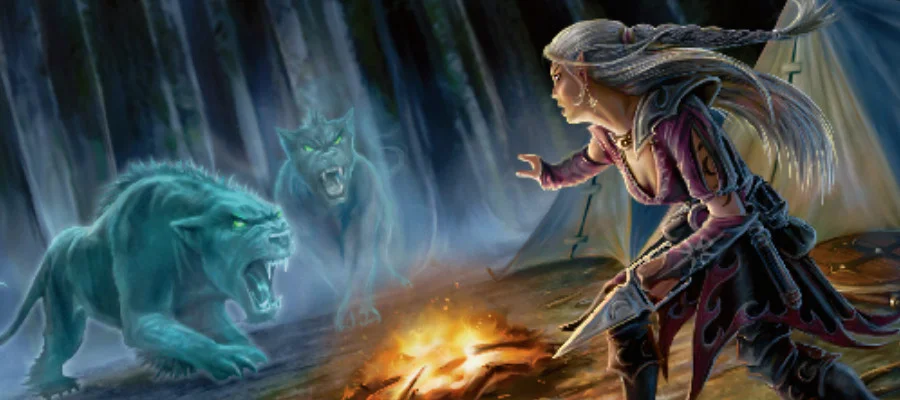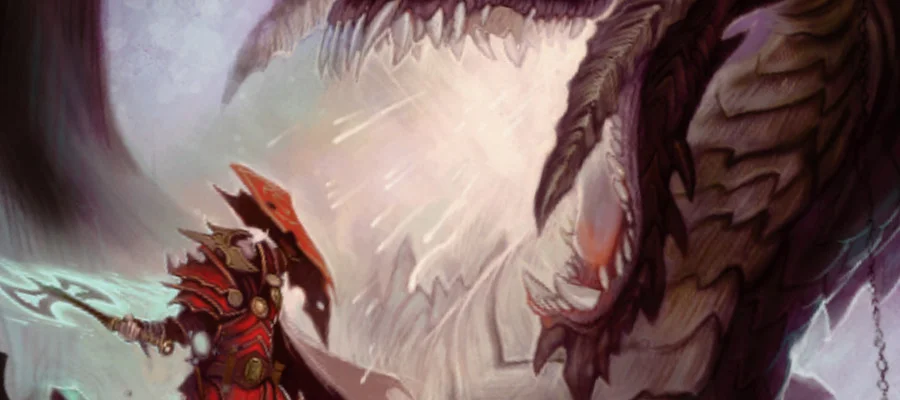Hey, have we already spoken about the monster system in 4th Ed D&D?
Back in 3rd edition, D&D used what we called the ‘challenge rating’ system, a system that treated each monster as a sort of amorphous blob with a generic personality and the option to pick its own feats and do a lot of possible things. It was a system that I’ve talked about somewhat negatively.

But people say that 4e D&D was ‘only good for tactical combat,’ which I don’t agree with, but I can understand the feeling when you consider it was the first time that it made the combat system kinda work (and obligatory ‘ew there were math problems in the first monster manual’ yep, and they found them and addressed it, thanks).
Part of how it worked was that rather than treat monsters as if they were all generic spots on a continuum, monsters were balanced based on general formulas of things they could do and ways they could be represented, and part of that was recognising that some types of monster were best suited to particular types of role.
Artillery
Artillery are fragile and mostly attack from range. In any given encounter, where you position artillery changes the game. Just one artillery in a hard to reach space creates a mini-game for people; getting to it and shooting at it before it gets back into cover, or teleporting up to it and stopping it from engaging with the group. Artillery can be arranged in groups, separated out, and even serve to defend one another. Just split your artillery across two locations and suddenly, one can support the other when players try to close in on them. Or they split up, and each artillery group reduces the damage they’re taking.
Brute
Big dumb hit point sponges. Brutes rarely have complicated abilities and their defenses tend to be very approachable. The challenge for a brute then is just absorbing hit points. Brutes make great damage sponges, and since they hit very hard, they also work well as protecting things like artillery without a feeling of helplessness; people will rarely need to feel like they need help with a brute, but they might find they need to withdraw to recover.
Controller
Aka ‘the mage you gank.’ Controllers are enemies that typically work at range, but not always, and the primary thing they do is find some way to deny players actions. Controllers will do it in a variety of ways, usually stuff like prones, pushes and stuns. Controllers are good at breaking the party up. This lets you use them in either a knot of enemies to push the party away and increase the turns your monsters have to act, or you can use them to pull the party apart and encourage separation (which makes the life of a leader harder).
Lurker
Alright, I’m going to level with you, a lurker’s job is usually to score a single hit, then get wiped out pretty quickly after that. They’re ambush types, they tend to have an encounter power that hits someone pretty hard, and that means they can be useful for making combat unpredictable. The other thing is, lurkers typically get simpler as the fight goes on; they do their thing, and then they’re just combat bodies, so you don’t need to keep remembering complex board states. Plus, if you have multiples, and one shows off a special ability, then the players will be cautious about them after that point, trying to make sure the other ones don’t get a chance to do that. This invites control and prepared defensive measures.
Skirmisher
Skirmishers are hit-and-run kind of monsters. They’re typically highly mobile, and they tend to hit reasonably hard but not take damage too well. This makes skirmishers useful to either split up the party (attack, then run off, inviting someone to chase), or to draw them into position (attack, then run back to others, inviting an ambush). Skirmishers are, a bit like artillery, good for rewarding non-melee types, but because they’re mobile, they can often force the players to move into unfavourable positions just to make their attacks.
Soldier
Soldiers are what I think of as ‘scrapey.’ Not scrappy – they’re not desperate and nimble. But rather, when you fight soldiers, you’re rarely going to expect to take them out with king hits. Soldier types are good for defending positions and protecting artillery, but they’re also dangerous in their own right. Soldiers also typically have good armour but not great non-armour defenses; which means that attacking reflex and will are good ways to punch through soldiers. This makes them great impositions on heavily physical party members (like most defenders), where then other party members can bring their abilities to bear on those soldiers to help. It’s a point of synergy.

Modifier Types
But in addition to those choices, there’s modifier roles; things that change the way the monster works in general:
Minion
A minion dies instantly from a single hit, and missed attacks don’t damage them. They’re hard to automatically get rid of, unless automatically getting rid of minions is your thing, but they’re very easy to get rid of if you bother. Minions are a useful tool for encounter design because they let you do things like represent a large crowd of enemies, like a bandit’s lair or a horde of zombies or a swarm of skeletons, without those bodies then becoming an enormous task for players to fight their way through.
Minions also block spaces; three minions in a doorway mean that alternate ways to get past them are valuable. They can form defensive lines for enemies, but also benefit from enemy buffs or protections.
Minions are a great tool for just making combat more varied. They give area damage dealers something to try and maximise, they give the DM more simple actions to care about, and they are a meaningful threat that rewards players for correctly determining how best to deal with them. It might be tempting to ignore them because you ‘waste’ damage when you attack a minion, but minions unchecked can really interfere with a strategy.
Elite
An Elite Monster is a useful way to spend the encounter’s resources on something that’s meant to serve as a centerpiece or a particular character. Balance-wise, an elite takes the XP value of two monsters and jams it together, resulting in a single monster that still takes a single turn, but can endure a lot of damage and attack back for a lot. Whatever role a monster does, an Elite does it better, often with multi-attacks or status ailments that forces players to pull back and reconsider their approach, or to pull out strategic tools to try and keep the Elite from going too wild.
Elites are great for players getting a chance to show off. They can shake things off, take action points, grant allies attacks, and sometimes have things like damage auras or status effects on move actions, which means that players are rewarded for keeping an elite controlled.
It’s basically a type of ‘boss’ monster – if your vision of an encounter is one or two important characters surrounded by the people under their command, Elites give you that option out of the box.
Solo
Solos are single creatures that are designed to be handled like they’re an entire party. They get to do things like act on multiple initiatives, big bonuses on saving throws, shed status ailments and basically are meant to be a danger that an entire party can throw their powers at all at once and it can survive and fight back. Solos are great for your giant monster encounters, and the most obvious use for them is that ‘dragon’ part of Dungeons & Dragons.
Thing is, they’re not handled the way things were back in 3rd edition; a dragon with enough HP to survive a party pounding on it for two or three turns might be enough levels beyond it that it now has abilities that the party can’t deal with. It’s not just a matter of scaling up individual damage, a creature needs some breadth to it – more hit points, yes, but without the armour class going so high players never land meaningful hits.
Solos, therefore, are the solution; you’ll find big enemies that are interesting encounters that kind of work just as is; you don’t need to do a lot or add to them. Maybe a few minions as packing peanuts or to force position. Maybe a single elite to serve as a way to split attention. The point of Solos is they suggest an encounter of their own, and that makes designing around them more about a space and a story than about worrying about the mechanics.
Leader
The final subtype is Leaders. These are monsters that have an ability or abilities that enable or improve other monsters. Leaders are something you gotta be careful about because when there are a lot of them, they can make the whole encounter too hard; the point of a leader is when you want to create some interdependence in a group.
Leaders are a great thing to combine with minions, too; because then, the minions can multiply the benefit of the leader, but destroying either the minions or the leader represents a strategy that benefits different kinds of players. Lots of single target damage on a single opponent, go for the leader, lots of area damage, go for the minions.
All of this is a form of affordance. By giving you an idea of what monsters can do and how they can do it, the game invites you to think about what you can use them for. Like a big red button and a big blue button, you’re immediately invited to assume you’re meant to push them. When a monster’s type line says ‘artillery’ it already implies a basic way to treat them in combat, smoothing along the experience of running them. And finally, by recognising the value of some monsters as very weak and some monsters as very strong, the game presents you with tools for building a variety of encounters. It doesn’t leave it up to you to come up with all the ideas.